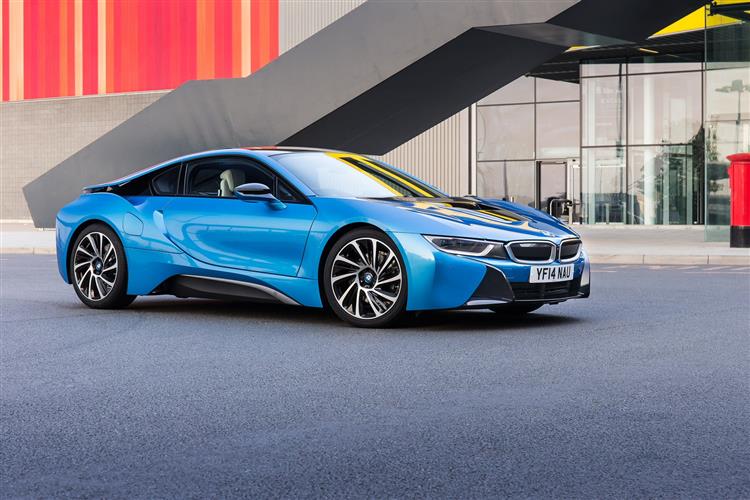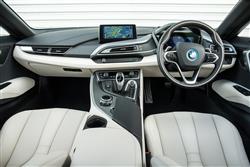THE I'S HAVE IT (some text hidden) --NONE--
By Jonathan Crouch
Introductionword count: 77
Forget everything you know about what a top sportscar should be - and start again. This is, after all, exactly what BMW did with this i8, which sold between 2014 and 2020. It's a plug-in petrol/electric hybrid supercar that runs silently on its battery in the morning commute, yet transforms itself into something like a Porsche 911 when you're in the mood. It also looks sensational, feels special and will slash your running costs to the bone.
Modelsword count: 2
2dr Coupe
Historyword count: 387
In its period, BMW's revolutionary i8 was arguably the most interesting car of any on sale, possibly the cleverest and probably one of the most significant, not least in the way it democratised exclusive technology in its segment. Until the i8 arrived in mid-2014, plug-in petrol/electric hybrid sportscar motoring required the billionaires' budget needed for ownership of hypercars like the Porsche 918 Spyder, the La Ferrari and the mighty Mclaren P1. At a stroke, this BMW changed all of that, delivering an equally sophisticated taste of the future, but doing so for realistic Porsche 911 money. The i8 set out to do nothing less than deliver the speed of a supercar with the running costs of a supermini thanks to a technological CV that even embarrassed the exotic models we've just mentioned. Under the skin lie two gearboxes, three electric motors and a sophisticated three cylinder turbo petrol engine, this boosted by a 200kg bank of hi-tech lithium-ion batteries and transmitting torque to the tarmac via a four wheel drive system. It's all clothed in a lightweight body fashioned from aluminium and the kind of carbon fibre-reinforced plastic you'd find in a Formula One racer. Here, in other words, is a machine that makes existing top petrol-powered sportscars look about as cutting edge as a video cassette recorder. This was the second of the Bavarian maker's new-generation i-branded models and at launch, seemed at first glance more of a motorshow concept than a production reality. Indeed, for several years, that's exactly what it was, this design originally introduced badged as a 'Vision EfficientDynamics' prototype in 2009, before evolving into road-ready form and being displayed to the crowds at Frankfurt in 2011 just as a purpose-built Leipzig production line was being readied for an exclusive manufacturing run. The development care was crucial given the boundaries being broken here. This, after all, was the first car BMW had ever developed with Plug-in hybrid technology. The i8's mid-engined configuration was almost unique for the brand too, the company's M1 supercar from the late Seventies being the only other model the marque had ever made with such a layout. This then, was Munich's miracle, the Coupe model we're going to look at here joined by an open-topped Roadster body style in 2018. The i8 sold until 2020 - and wasn't replaced.
What You Getword count: 424
It seems appropriate that such unique engineering should be so uniquely fashioned. Clearly futuristic, the i8 is every inch a BMW - and every inch a sportscar with its long wheelbase, short overhangs and solid stance. Even standing still, there's a sense of theatre here, with a riot of complex surface treatments, contrasting colours, sharp creases and scalloped sills. Setting this coupe i8 apart from the equally arresting open-topped Spyder version of this design is the so-called 'stream flow' contour of the side window styling. It's intended to reflect the path of airflow between the falling roofline and the distinctive character crease that rises across the muscular wheelarch towards the lip of the rear spoiler. It's the doors you'll be talking about most though. Dihedral doors are rare enough in automotive design but these ones (only fitted to a Coupe i8) are particularly unique, fashioned from aluminium, carbonfibre and thermoplastic and so light and easy to use. In the cabin, you'll find the styling as futuristic as it was outside, the curved, layered dash made up of overlapping three-dimensional segments and complemented by contrasting colours. You sit low on slender leather sports seats cocooned in a driver-focused cockpit dominated by two 8.8-inch screens. One of these should at least be familiar to the BMW faithful, a central iDrive infotainment display that rises from the centre of the dash and deals with all the things that don't directly concern the performance experience - like Navigation, the stereo system and the many 'ConnectedDrive' technology features this car borrows from its more conventional brand stablemates. More arresting though, is the display you view through the grippy three-spoke wheel, a sci-fi-style layout which delivers range readings for fuel and battery power below two circular digital dials that change in colour depending on the driving mode you select. Of more importance perhaps, is the news that all-round visibility is much better than some rival sportscars provide, helped by a wide rear screen. Talking of the rear, the 2+2 cabin layout in the coupe means that, as in a 911 but in contrast to, say, an Aston Martin V8 Vantage or a Jaguar F-TYPE R, you get a couple of extra useful but rather upright chairs. And you may need them because, as with most mid-engined cars, the boot is pretty restricted in size - and can also get quite hot due to the proximity of the engine. The Coupe model's trunk is 154-litres in size - just about big enough for an airline carry-on bag and not much else.
To see the full road test text contact us on 0330 0020 227
Pictures (high res disabled)

.jpg)
|
.jpg)
|
.jpg)
| |||
.jpg)
|
.jpg)
|
.jpg)
| |||
.jpg)
|
.jpg)
|
.jpg)
| |||
.jpg)
|
.jpg)
|

|
Scoring (subset of scores)
Category: Hybrid, Plug-in, Electric & Hydrogen
| Performance | |
| Handling | |
| Comfort | |
| Space | |
| Styling, Build, Value, Equipment, Depreciation, Handling, Insurance and Total scores are available with our full data feed. | |



